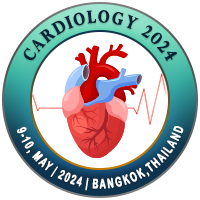
Kaneez Fatima Shad
University of Technology Sydney, AustraliaTitle: Can reactive Human Fetal Astrocytes (HFAs) mimic Hypertensive state?
Abstract
According to WHO, hypertension is a major risk factor for cardiovascular and cerebrovascular diseases, causing premature deaths globally. Therefore, this problem should be addressed urgently.
Literature shows various molecules as biomarkers for hypertension (HTN), but most of them are produced because of hypertension and related disorders. Therefore, we are looking for those molecules that can identify healthy individuals susceptible to have high blood pressure in future.
We are using both animal and cell models to detect such biomolecules by applying techniques such as confocal microscopy, liquid chromatography tandem mass spectrometry (LC-MS/MS) and enzyme linked immunosorbent assay (ELISA).
The spontaneous hypertensive rats (SHRs) and their normal counter parts (WKY) rats were used as animal model, whereas human foetal astrocytes (HFAs) both reactive (A1) and non-reactive (A2) as cell model.
Our confocal microscopic studies using anti-GFAP antibodies indicate that A1 HFAs resembles the astrocytes from SHR as both have very similar elevated profile of glial fibrillary acidic protein (GFAP), an index of astrogliosis. We are using HFAs to examine the biomolecules which may function as predictive biomarkers for hypertension.
Calcium channel blockers, such as Amlodipine (Norvasc) Diltiazem (Cardizem) are commonly used as antihypertensive drugs. Similarly, numerous studies point to a significant role of calcium dependent proteins in hypertension.
By employing LC-MS/MS we observed that reactive (A1) astrocytes, contain more calcium activated proteins such as calpain, calpastatin, cathepsin and mitogen activated protein kinase (MAPK) as compared to normal (A2) HFAs, suggesting their possible link to the future onset of hypertension (HTN). We also used ELISA technique and found that beside Glial fibrillary acidic protein (GFAP), S100 calcium binding protein B (S100B) and astrocytes Soluble receptor of advanced glycation end product (sRAGE) are also elevated in the reactive astrocytes and may also be considered as potential candidates for predictive biomarkers of HTN.
Biography
Kaneez Fatima Shad is a professor of neuroscience and translational clinical research, Sydney Australia. Visiting professor, professor, researcher, and academic of major Australian. She is an Australian neuroscientist with a medical background, received her PhD in 1994 from the faculty of medicine, UNSW, Australia, followed by postdoctoral research at the Allegheny University of Health Sciences, Philadelphia, USA. She has taught medical and biological sciences at various universities in Australia, the USA, UAE, Bahrain, Pakistan, and Brunei. During this period, she has been engaged in research, obtaining local and international grants totalling over 3.5 million USD and translating them into products such as rapid diagnostic tests for stroke and other vascular disorders such as schizophrenia. She has published over 60 articles in refereed journals, edited nine books, written 10 book chapters, presented at over 85 international conferences, and mentored 34 postgraduate students. She is a mentor and a protocol development specialist.

